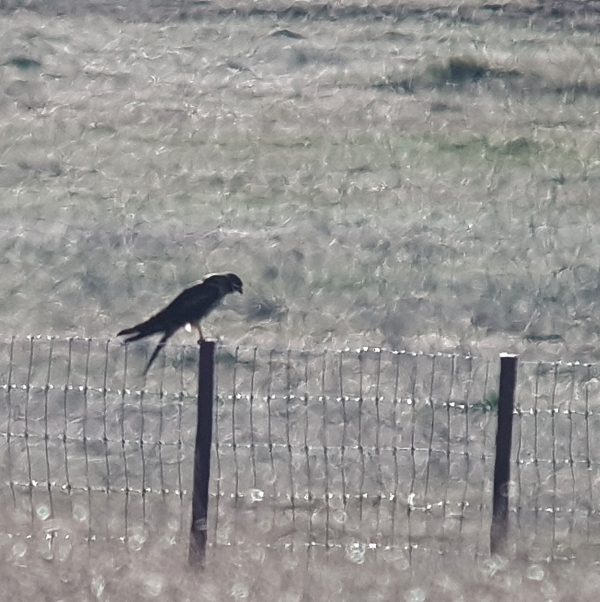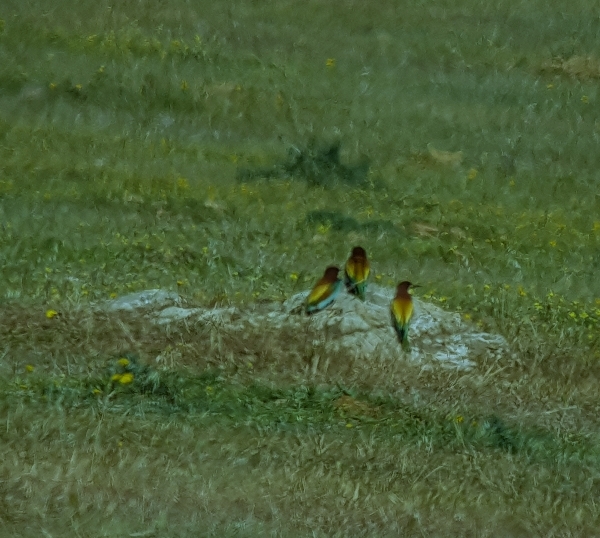
THE PLAINS AROUND SANTA MARTA DE MAGASCA AND CÁSERES
WEATHER: all day sunshine, some high cloud later temp range 2-24C
It was bitter cold at 7am as we left the hotel in the dark carrying our breakfast in a bag, picnic style, the bus registered just 2C!!
We drove straight down to Trujillo and saw nothing at all until we got there some 30minutes later. It was just starting to get light as we entered the town. We nipped into a café for a quick cuppa coffee and a snack and by the time we reached the huge silos on the southern edge of town it was light. We parked next to the silos and set up our scopes to watch the LESSER KESTREL colony, it is huge now 40-50 pairs of Kestrels breed in boxes provided by the local environmental group, they were swarming around them like ants in the sky. Unfortunately, because of the low light all of my pictures were blurred and this set the theme for the day, read on!

recrod sot of one pair of Lesser Kestrels
We drove a few kilometers towards Cáseres and stopped at a bridge over the Rio Magasca. Usually there are many species around this ancient bridge but the whole area had been devastated by flooding at some stage during the winter, all the bushes were flattened and uprooted and the reedbeds were lying flat. It looked like a flood of biblical proportions had washed through the area. We saw Corn Bunting, Cetti’s Warbler, Sedge Warbler, Spanish Sparrows and a distant Woodchat Shrike. The usual White Storks, Black Kites and Griffon Vultures began to take to the air, the temperature had risen to 6C.

a typical White Storks nest with a colony of Spanish Sparrows within it.
As we drove along the N-521 we stopped to view a pond which had many Black-winged Stilts around it and a couple of pairs of Gadwall on the water. We noted Iberian Grey Shrike and more Corn Buntings! Turning onto the CC 57.1 toward Santa Marta we stopped on a tight bend to view the surrounding fields, most we open and held cattle or sheep and some were covered in small broom bushes.
We searched for Stone Curlews there and we heard one calling but never found it. Calandra Larks were everywhere, it Mark a little while to get to grips with the size and the number of these birds. Corn Buntings were the same, dozens of them everywhere, also flocks of Spanish Sparrows were all over the place and Crested Larks sat on all the posts and fencelines that weren’t occupied.

typical view of the open plains
Our next stop was the ‘biggie’ my favourite place from where to watch Bustards and Sandgrouse. We parked the bus and set up our scopes and shazam! A small group of Pin-tailed Sandgrouse sat not too far away looking fantastic in the morning sunlight. I reached for my phone to take picture, oops! It wasn’t there, I had left it in the bus. As I moved back the birds took off and flew over the road into a filed but out of sight below a ridge. Doh!
Now armed with my phone I scanned for more sandgrouse but all I found was a very distant female Great Bustard, then a male not too far from the first bird he was displaying, both of these birds were along way off. We found a third bird and then a Montagu’s Harrier, ringtail, quartered the field.

record shot of the Great Spotted Cuckoo
A short walk got us into a position where we could see where the sandgrouse had landed, Mark picked out the first bunch of about ten. We went on to see a flock of some seventy birds, what sight and noise they made as they flew around. All of these birds were too distant to photograph.
Looking back into the first field we found a single Little Bustard, a female, she wandered around in longer grass with only head, neck and shoulders showing, we never saw a male there!

some of the 70+ Pin-tailed Sandgrouse
Driving along the road we turned onto an unmade track and stopped many times to scan the fields around us. The Montagu’s Harrier returned and then a second one and a Great Spotted Cuckoo was found along the fence line ahead of us. I tried to get nearer for a photograph, but the bird would not behave itself! We got very close in the bus but to take a picture I need to set up my scope which is impossible in the driver’s seat!

female Montagu's Harrier
More birds of prey appeared in the sky, we added Red Kite, Short-toed Eagle, Black Vulture, Common Kestrel and we found a Spanish Imperial Eagle perched on the top of a eucalyptus tree, very distant! We spent an hour on that track searching many fields looking for Black-bellied Sandgrouse without luck! Other birds seen were Stone Curlew (distant), Hoopoe (several) European Bee-eaters (several small flocks) and countless Calandra Larks, Corn Buntings, Crested and Thekla Larks and large flocks of Spanish Sparrows and Spotless Starlings. I got onto a superb male Spectacled Warbler working its way along a fence and as we left the track Mark spotted another Cuckoo, but it flew off as we reversed the bus.

Marbled White Butterfly
After driving into Santa Marta to buy lunch supplies, we took the CC-99 towards Cáseres and stopped on a bridge over a small stream to eat it. Both White and Grey Wagtails were seen, also Serin, Goldfinch, Chaffinch and lots of Crag Martins were nesting under the bridge. Further along this road we watched Shoveler, Gadwall, Black-headed Gulls and a Great Crested Grebe, all very distant in a large pond.
Also this road there are many nest boxes attached to telegraph poles, they are intended for Rollers, but Jackdaws, Starlings and Kestrels have taken over many of them. We drove slowly past the poles hoping for an early Roller and we got lucky! A superb bird sat near one of the poles, it gave us a flight display as it caught a passing bee. What a beauty!

European Roller
Next, we turned onto an unmade road that was 25 kilometers long and very bumpy in places, but we had an excellent time stopping and starting and viewing many birds. We added a few species to the list, Little Owl, Northern Wheatear, Green Sandpiper, Greater Short-toed Lark and we saw a stunning male Montagu’s Harrier, what a sighting that was.

European Bee-eaters
It was now late afternoon, we had two more sites to visit, I think we had given up on the BB Sandgrouse by then. A very impressive bridge spans a gorge over the river Almonte on the EX-390 towards Torrejón el Rubio, we stopped there for a little while. Crag Martins, dozens of House Martins, Barn and Red-rumped Swallows dashed about under the bridge, visiting their nests. A few pairs of Alpine Swifts were also present, you can get very close views of these magnificent beast from beneath the bridge.

the Bridge over the Rio Almonte
We searched for Black Wheatear and found a pair of them, both distant but good scope views. We never found a Blue Rock Rock Thrush as I usually do!
The Large Reservoir at Talavan looked as though that had been flooded too, all the reedbeds were flattened. We spent an hour there watching a few waterbirds, Moorhen, Coot, Gadwall, Shoveler, nothing new for our list. Mark found yet another Great Spotted Cuckoo, he is getting good at that! We heard a distant Common Cuckoo and a Hoopoe was calling too.

Spanish Sparrows using the shelter of the White Storks nest to build their own nests
We called it day after that and got back to the hotel just before 6pm, we added our first Common Buzzard to the trip list on the way back as well as adding svereal species to the day list which turned out to be our highest for trip at 69.
